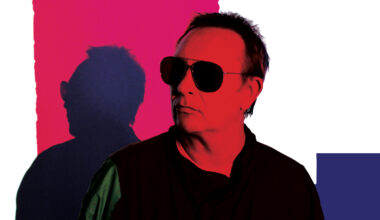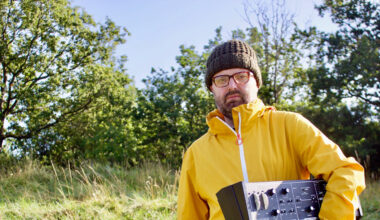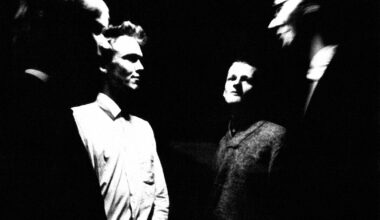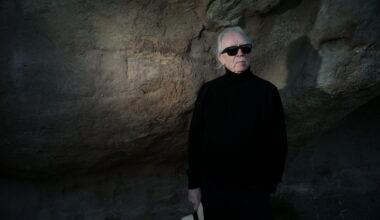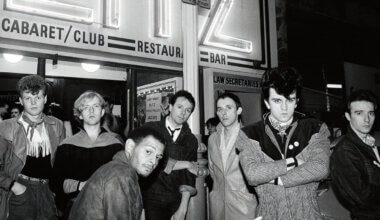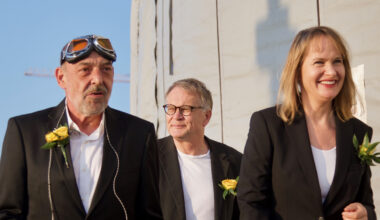Dr David Butler at The University of Manchester has been researching the life and work of Delia Derbyshire with access to her personal archive. Here he delves into her pioneering work with visual art, and dismantles the myth of her post-BBC activity
As the 1970s began, Delia Derbyshire appeared to be at the height of her creative activity. Based at the BBC Radiophonic Workshop since 1962, by the end of the decade Derbyshire’s distinctive electronic and tape-based music and sound design had earned her the respect and admiration of colleagues and collaborators both within the BBC and elsewhere. Thanks to her work in theatre, film, and diverse live events and installations, her profile as a freelance artist was burgeoning.
In 1968, her work featured in two pioneering British concerts of electronic music at the Queen Elizabeth Hall in London and Liverpool University’s Mountford Hall respectively, but by this point in her career she was already active in theatre and film, with productions including work for the Royal Shakespeare Company and the London Roundhouse. Having established the short-lived Unit Delta Plus (1966 – 67) with the engineer and composer Peter Zinovieff and her close friend and fellow member of the Radiophonic Workshop, Brian Hodgson, in the late 1960s she co-founded Kaleidophon, a second independent organisation for the development of electronic music, with Hodgson and David Vorhaus, in order to further this increasing freelance activity.
The early 1970s saw Derbyshire involved with innovative and rewarding projects both within and beyond the BBC. In July 1970, she collaborated with Edward Lucie-Smith on ‘Poets In Prison’, a special event at City Temple Theatre as part of the City of London Festival, featuring “in semi-dramatised form the outcries of the Muse in chains” alongside projections and Derbyshire’s music. Less than six months later, in January 1971, she provided music for a BBC Radio 4 schools broadcast of Ted Hughes’ ‘Orpheus’, billed in the Radio Times as a new verse play for lights, voices, dancers, and music, with Derbyshire’s score evoking the voices of stones and trees. The production won an award at that year’s Japan Prize contest. Yet, barely two years later, Derbyshire was gone from the BBC and Kaleidophon.
The working conditions at the BBC Radiophonic Workshop in the early 1970s were on record as being difficult, in part due to a lack of adequate resources, resulting in the manager, Desmond Briscoe, expressing his concern about the well-being of his staff. To combat this pressure, the Radiophonic Workshop invested in several synthesisers, but Derbyshire found them less satisfying than her more time-consuming tape-based and musique concrète approach, which placed the emphasis on generating and crafting her own distinctive sounds.
“I didn’t want to compromise my integrity any further,” she told Peter Kember, aka Sonic Boom, in 1999. “I was fed up with having my stuff turned down because it was too sophisticated, and yet it was lapped up when I played it to anyone outside the BBC. The BBC was very wary, increasingly being run by committees and accountants, and they seemed to be dead scared of anything that was a bit unusual. And my passion is to make original, abstract electronic sounds and organise them in a very appealing, acceptable way, to any intelligent person.”
So what happened to Delia Derbyshire after she left the BBC? Where did she go next and what did she do? The standard narrative of Derbyshire’s life is that her departure from the BBC in 1973 marked a complete withdrawal from creative activity in general and creating new music in particular, until in the late 1990s and early 2000s, when she began to collaborate with the musician Peter Kember.
In fact, Derbyshire remained both creatively engaged and active as an artist far longer than has often been reported or assumed. In particular, her creative activity during these years saw her collaborating with visual artists, most prominently Madelon Hooykaas and Elsa Stansfield, as well as a period assisting the Chinese-born artist Li Yuan-chia at his celebrated LYC Museum and Art Gallery in north-east Cumbria. In doing so, Derbyshire furthered her long-standing interest in the relationship between music and the visual arts.
An obvious influence in terms of the integration of electronic music and visual art was her experience of attending Le Corbusier’s Philips Pavilion, designed for the 1958 Brussels World’s Fair. Derbyshire travelled to Expo 58 with her friend and fellow music student from Cambridge, the composer Jonathan Harvey. As they entered and left the Pavilion, they would hear Iannis Xenakis’ musique concrète piece ‘Concret PH’ and, within the Pavilion, Edgar Varèse’s ‘Poème Électronique’ was synchronised to a film of black and white photographs in addition to shifting patterns of coloured light. The music was diffused via a complex sound projection system, which employed several hundred speakers that could be activated in varying combinations to transform the nature of the sonic presentation and the spatialisation of Varèse’s composition.
The experience had a profound impact on Derbyshire: within 10 years, she was contributing to, as well as co-organising, immersive environments and events that brought visual projections and electronic music together. An enduring interest in the relationship between music and visual art was cemented.
In 1965, an encounter would have a significant impact on the nature of her freelance work outside the BBC. The incident in question was a visit to the Workshop by the artists Clive Latimer and Michael Leonard, and the result was a fruitful collaboration between Derbyshire and the Light/Sound Workshop at Hornsey College of Art.
The LSW was formed in 1963 and was part of the Advanced Studies Group at Hornsey under Latimer’s direction. The LSW was at the forefront of experiments in Britain to explore the relationship between sound and light projection. Their first professional performances took place in 1963, including a combination of lighting and image projection onto a cycloramic backdrop for the production ‘Ex-Africa’ at that year’s Edinburgh Festival, which combined poetry, jazz, and dance with the LSW’s projections.
Leonard wrote to Desmond Briscoe on 19 May 1965 thanking him for the opportunity to visit the Radiophonic Workshop in order to discuss electronic music with Briscoe and his staff, offering, in return, a visit to the Light/Sound Workshop “to show you our own techniques of light projection”. The possibility of the two facilities collaborating, perhaps gathering on an evening to see how “visual material could be related to any existing tapes” or developing an improvisation around Radiophonic Workshop material, was suggested by Leonard, and Derbyshire seems to have responded enthusiastically.
Although short-lived, Unit Delta Plus (Derbyshire, Brian Hodgson, and Peter Zinovieff) held or contributed to a number of innovative events that experimented with sound, light, and image projection. The first of these was a concert at the fledgling Watermill Theatre in Bagnor on 10 September 1966 (the Watermill had only just been converted and would not produce its first professional season of theatre until the following year).
Billed as “Unit Delta Plus Concert of Electronic Music”, the event was a genuine collaboration between Derbyshire, Hodgson, and Zinovieff and the Light/Sound Workshop. Correspondence between Leonard and Unit Delta Plus reveals that considerable thought was given to how the sound and images should interact, and Leonard met with Derbyshire to discuss possible approaches to the relationship between the sound and light projections at the event.
Derbyshire was pivotal in the event’s development, securing permission to use an extract from ‘Amor Dei’ for “a non-profit-making concert of electronic music, to be given before an invited audience at a private theatre” that “I am organising”. The projections were abstract in nature and, as Brian Hodgson recalls, took the form of slowly moving coloured oils, oozing around “like a flattened, multi-coloured lava lamp”. This was a significant event, pre-dating some of the more prominent concerts of electronic music held in Britain in 1968 and, according to Hodgson, it was very successful.
Unit Delta Plus followed the Bagnor concert with their participation in another event bringing together sound and light projections: the Million Volt Light and Sound Rave, held at the Roundhouse in London on two nights in late January and early February 1967. This particular happening has acquired legendary status through the involvement of The Beatles and their ‘Carnival of Light’ piece, which has still to receive an official release having been vetoed by surviving members of the group, despite Paul McCartney’s wish to put the recording out. There is little documentation confirming the full extent of Derbyshire’s involvement at the event and how the Unit Delta Plus material might have interacted with the visuals.
“As usual in those days,” says Brian Hodgson, “it was complete chaos with no one really knowing what was going on… lots of noise and people milling about… we eventually found someone to take charge of Paul McCartney’s tape and after a few minutes we left and went to the pub. I have no recollection of whatever, if anything, was played from Delia or Unit Delta Plus.”
Far better documented is Derbyshire’s contribution to the K4: Kinetic Four Dimensional immersive environments that were installed on the West Pier as part of the first edition of the Brighton Festival, from 14-30 April 1967. These “kinetic/audio/visual environments”, incorporating the mechanical sculptures of Bruce Lacey and the music of Pink Floyd, were instigated by the Light/Sound Workshop.
Four distinct environments were outlined by Clive Latimer in November 1966: Kinetic Arena, Kinetic Labyrinth, The Dream Machine, and Balloon Structures (aerial structures of helium-filled balloons, which were to be tethered over the pier and floodlit at night). Kinetic Arena was designed to be a large-scale social space for dancing, with 30 loudspeakers providing a sense of surround sound and continuously developing moving images projected onto a white elliptical cyclorama. Conversely, Kinetic Labyrinth was intended to be “a more enclosed and personal experience”.
The Labyrinth was to showcase the work of British and international kinetic artists, with an emphasis on generating a contemplative mood through colours and images being projected onto Perspex walls with sonic accompaniment, shifting to pulses of light, strong colour, and a sense of “illusion and disorientation”. The Dream Machine was intended to provide an even more intimate experience, aimed at the solitary individual with the emphasis on fantasies and creating in the subject a sense of being immersed within the image.
Building on their earlier work together, Michael Leonard wrote to Derbyshire on 13 December 1966 to confirm that the project was going ahead and that the LSW would require at least half an hour of electronic sound from Derbyshire with individual pieces structured to the requirements of the programme, ranging from three to 10 minutes in duration.
Derbyshire’s audio archive at the University of Manchester contains two tapes with labels referring to the Brighton Festival event: one is labelled “Extracts from Brighton Festival” and runs for just under four minutes and the second is labelled “2 Bands – Labyrynth, Beachcomber for Brighton Festival 1967” and contains two cues running for just under eight minutes and eight minutes 30 seconds, respectively. The majority of these cues for the K4 environments comprised collages, re-edits, and transformations of some of Derbyshire’s existing work segueing into fresh configurations, but there is original material as well.
This repurposing of existing material was true of Derbyshire’s final collaboration with Leonard, The Coloured Wall at the Association of Electrical Engineers Exhibition at Earls Court, which opened in late March 1968 (and featured, again, elements from ‘Moogies Bloogies’ and ‘Way Out’ as well as her special sound for Ron Grainer’s 1966 musical ‘On the Level’ and the 1968 film ‘Work Is A Four Letter Word’).
By now, Unit Delta Plus had folded and Derbyshire’s freelance activity was undertaken through Kaleidophon. The Light/Sound Workshop would soon be at an end as well. Clive Latimer was expelled from his post at Hornsey College of Art after he supported the student uprisings of May 1968.

The 1960s closed with Derbyshire having generated considerable experience from collaborating with and advising visual artists interested in the possibilities of electronic sound and music. Although the following decade would bring major changes in the nature of her creative activity, her interest in and involvement with visual art would continue as a crucial and rewarding aspect of her life.
If the collaboration with Hornsey College of Art’s Light/Sound Workshop was the most significant that Delia Derbyshire had with visual artists in the 1960s, then her most important collaboration in the 1970s was with Stansfield/Hooykaas. Working initially under the title White Bird, Stansfield/Hooykaas was the collective name for the Scottish artist Elsa Stansfield and the Dutch artist Madelon Hooykaas.
The two first met in London in 1966, but began their lengthy collaboration in 1972. Over the course of the following 30 years, Stansfield/Hooykaas would create a rich body of work that integrated aspects of art and science with a particular interest in time and memory. Training as visual artists (painting; and drawing and photography, respectively), their initial collaborative projects were in film but, in the mid-1970s, they transferred their attention to video and gallery installation pieces, being among the first European artists to have videos exhibited in gallery spaces.
They collaborated with Derbyshire on two films, ‘Een Van Die Dagen’ (‘One Of These Days’) in 1973 and ‘Overbruggen’ (‘About Bridges’) in 1975, but Derbyshire’s influence would remain a tangible presence in many of their video and installation works into the 1980s and beyond.
Derbyshire had already worked with Stansfield on the 1972 award-winning art film ‘Circle Of Light’. Directed by Anthony Roland, the film shimmers and drifts through the luminous and haunting photography of Pamela Bone: uncanny evocations of beaches, marshland, forests, and sunsets. With the exception of a brief introduction from Bone, the film is wordless, set to a slowly shifting soundscape of natural, elemental sounds and animal calls, blended with Derbyshire’s music at its characteristic ambient best.
That positive experience resulted in Derbyshire being commissioned by Stansfield and Hooykaas for their first full collaborative film, ‘One Of These Days’. Stansfield was now established at her new studio facility, 8, 9 and 10, named after its location in Neal’s Yard, above the market in Covent Garden. The space was converted and equipped for editing as well as animation and it was here that Brian Hodgson founded Electrophon after he left the Radiophonic Workshop in 1972.
Derbyshire completed the music for both ‘One Of These Days’ and ‘About Bridges’ at the Electrophon facility, the second project being undertaken after she left the BBC in 1973. ‘One Of These Days’ was shot in Amsterdam and Rotterdam during October 1972 and Derbyshire was involved from an early stage of the production. The collaboration was especially rewarding for Derbyshire, and, as her partner Clive Blackburn acknowledged, she loved working with Hooykaas and Stansfield.
‘One of These Days’ and ‘About Bridges’ were screened on Dutch television and at international festivals in cities including Toronto, New York, Grenoble, and Rotterdam. But Stansfield and Hooykaas were frustrated at the limited exposure their work was receiving and the high cost of film-making. They “much preferred to see our work shown in a visual arts context. By making our own exhibitions and being present there, we hoped for a more immediate, personal response”.
Instead of emphasising the lone, exceptional genius, Derbyshire’s collaborations, taking in her work with the Light/Sound Workshop, are an example of Brian Eno’s concept of “scenius”, which places the emphasis on “the creative intelligence of a community” with the innovations of individuals dependent on an “active flourishing cultural scene”.
By the time ‘About Bridges’ was released in 1975, Derbyshire had long since left London and relocated to the north of England, near the border between Cumbria and Northumberland, but her contact and creative interaction with Stansfield and Hooykaas was far from over. She was employed initially as a radio operator for Laing’s gas pipeline, liaising with French personnel in a major pipe laying operation, and it is generally from this point on that the standard accounts of her life tend to assert that she was no longer active as a musician.
Her creative activity, however, would resume in a professional capacity when she assisted the Chinese artist Li Yuan-chia at his LYC Museum & Art Gallery. This was no conventional museum or gallery. The range and influence of Li Yuan-chia’s visionary practice and philosophy has escaped the attention of many accounts of late 20th century art history.
The ultimate expression of Li’s thought and practice was the LYC Museum and Art Gallery. Li founded the LYC in 1972, buying a run-down farmhouse from the artist Winifred Nicholson and transforming it into a remarkable community arts space complete with a children’s room, print room, library, and space for visiting artists to stay and exhibit their work. All of this took place in the hamlet of Banks, right beside the line of Hadrian’s Wall and the LYC remained open until 1982.
Derbyshire was living in the nearby village of Gilsland, where she had married David Hunter, a local labourer, in the hope of being accepted by the rural community where she was conscious of her outsider status. The marriage was not a happy one. Instead, Derbyshire was drawn to the artistic vibrancy of the LYC, where she worked in 1976 and 1977 for little money, but could stay for free.
Staying at the LYC, Derbyshire gave Li crucial support in running the Museum and Gallery. According to her future partner, Clive Blackburn, “Delia loved the LYC because of all the visiting artists and sculptors… she used to spend ages talking with them… she loved mixing with any sort of creative people, really, not just in the music field.”
Her role was primarily to help arrange exhibitions, liaise with the artists, and entertain them during their stay. In this respect, Derbyshire was drawing on her existing organisational skills. She had managed the Radiophonic Workshop when Desmond Briscoe went on leave and had experience of putting together complex artistic events as demonstrated by the Unit Delta Plus concert at the Watermill.
Numerous visitors would pass through Banks on their way to and from Hadrian’s Wall. Whether or not the LYC was their planned destination, around 30,000 people a year visited at the height of the its success. Neither was Derbyshire’s life devoid of music during her time in Cumbria. According to Blackburn, she still possessed two pianos, her much-loved spinet (which provided what he describes as a form of therapy as Derbyshire delighted in playing the instrument loudly so that she could “drown” in its sound), an electric organ, and a VCS 3 synthesiser.
Derbyshire might not have been involved with any new projects as a musician during her time in Cumbria, but she remained, as Brian Hodgson reflected, “fascinated by the act of creation” and her work at the LYC required her to be creatively and artistically engaged. Nonetheless, the years that she lived and worked in Cumbria were not easy for her.
By 1978, Derbyshire had returned to London and, having met Clive Blackburn, she would move to Northampton with him in 1980, leaving her cat, Horribles, with Li Yuan-chia. Relocating to Northampton enabled her to be close enough to meet with friends in London and also make visits to her mother in Coventry. For Hodgson, Derbyshire’s relationship with Blackburn meant that “probably for the first time, she found happiness and settled into what, for her, was a normal existence”.
She continued to be interested in music and, contrary to the vast majority of reports about her post-BBC creative activity, still took on the occasional project. In the late 1970s, she collaborated with the Polish artist Elisabeth Kozmian on her 1980 “experimental documentary” ‘Two Houses’, having been recommended and introduced to Kozmian by Madelon Hooykaas and Elsa Stansfield at their Docklands studio in London. Kozmian was fascinated by Derbyshire: “a cheerful majestic figure”.
Following the creation of a trial draft theme at a recording studio in London, Kozmian commissioned Derbyshire. The result was a wholly original and lyrical score for piano. The film was funded by the Arts Council and consists of a series of re-photographed colour slides, seen variously in negative and colour, and the voice-overs of the owners of two houses in the process of renovating their respective new homes in Kentish Town, north London.
‘Two Houses’ was screened at the Institute of Contemporary Art in London and at various other one-off events, but Derbyshire’s involvement was little known and unreported in accounts of her work until a remastered edition of the film, facilitated by the author and late-period Workshop recruit Mark Ayres, was screened at Manchester’s HOME in 2016 and BFI Southbank in 2017 as part of events celebrating Derbyshire’s film collaborations with visual artists.
‘Two Houses’ finds Derbyshire active as a composer and collaborating on a project over six years after her assumed withdrawal from creative activity. In 1980, Kozmian discussed with Derbyshire a second film project, ‘Clothes’, but this was never realised beyond a single 90-second demo cue. The two met in a London recording studio, where Kozmian sang an old Polish folk song that provided the inspiration for Derbyshire’s cue: a gentle synthesised wordless lullaby with a sense of the sacred (not dissimilar to the tone of much of Derbyshire’s score for ‘Amor Dei’).
Kozmian recalled a man “recording and playing with that singing electronically”, which suggests that Derbyshire might have employed a vocoder to create the finished effect. Whatever the instrument, the cue provides a tantalising glimpse of what might have been in the project with Derbyshire utilising a form of technology she had not used before.
Throughout the 1980s and 1990s, Derbyshire was approached to participate in various projects with her usual response being to say, “No, I’m not working anymore”, but there were exceptions.
Clive Blackburn recalls her working at the studio of Wasp synthesiser inventor and great-great grandson of Richard Wagner, Adrian Wagner, where she created the title music for a factual programme about Stonehenge. Privately, she and Blackburn worked on and recorded some songs for their own interest and pleasure, but these were never released and that is, perhaps, the way they should remain.
It is all too easy, as we have seen, to characterise this lengthy period of Derbyshire’s life as one of failure and defeat, unfulfilled potential and “hopeless” waste. To do so, however, is to deny Derbyshire any agency in her decisions to not release private material, turn down requests to compose or leave the BBC, and explore rewarding and meaningful alternatives in her life that do not correspond with assumptions about what a successful artist should be. Derbyshire’s departure from the BBC was an act of self-preservation and the years in Cumbria show her displaying her characteristic resourcefulness.
Her life, career, output, and influence were complex and more diverse and significant than we have assumed, taking in experiments in the audio-visual relationship and ground-breaking figures in video art as well as her more familiar achievements in electronic music. Delia Derbyshire continues to surprise and confound easy categorisation, but that is something to be celebrated, however problematic it might be for neat overviews and headlines about her body of work. Her example is a reminder of the need for more nuanced narratives that are equal to the collage of challenges, the often sudden disruptions, delights, departures, and mysteries that form the cut and spliced nature of our lives.
This is an edited version of an article that first appeared in British Art Studies, Issue 12. For more, visit britishartstudies.ac.uk

